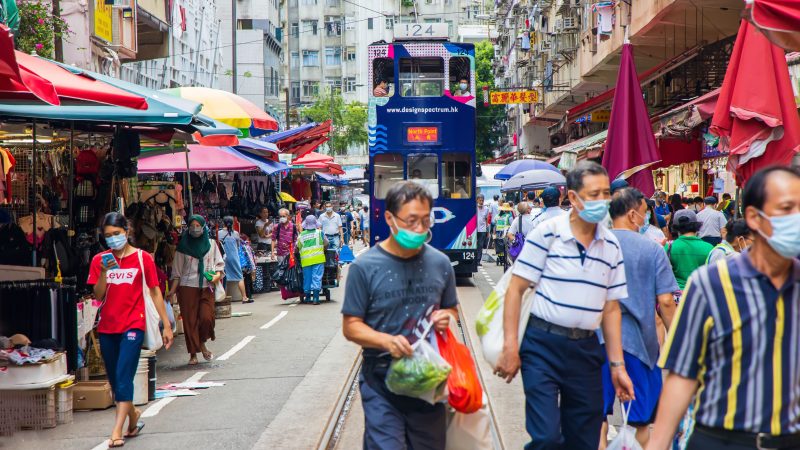
SINGAPORE, November 23, 2020 – Hong Kong, China’s [1] economy and financial system remain resilient despite the pronounced deterioration of growth and employment conditions due to the COVID-19 pandemic. Solid macro fundamentals, labor market flexibility, high levels of foreign and fiscal reserves, and the banking system’s ample buffers have underpinned the resilience of the economy to severe strains. It is expected that the authorities would be able to combine judicious use of fiscal resources with increasingly targeted support measures to strengthen growth recovery and job creation in the later part of 2020 and in 2021. This is according to the 2020 Annual Consultation Report on Hong Kong – published by the ASEAN+3 Macroeconomic Research Office (AMRO) today, based on AMRO’s Annual Consultation Visit to Hong Kong from July 13 to 24, 2020, and data and information available up to 25 August 2020.
Hong Kong’s real GDP contracted more sharply from -1.2 percent in 2019 to -9.0 percent in H1 2020. Higher-frequency data in Q3 2020 continued to be weak. The recovery path ahead will likely be gradual and bumpy. Growth is expected to come in at -7.5 percent for the year, reflecting a prolonged weakness in economic activities across sectors, the rise in unemployment and underemployment, and subdued business sentiment. It is expected to grow by 4.5 percent for 2021, with the headline outcome helped by base effects.
Headwinds have become stiffer since the turn of the year. Adverse feedback loops have formed between businesses and the labor market. As a result of earnings pressure and liquidity strains on enterprises, job losses have become broad-based. These adverse employment conditions have in turn undermined capacity and appetite for consumption and investment. On the other hand, exports have picked up recently, helped by Mainland China’s firming growth.
Looking ahead, the top risk is that recurring outbreaks of COVID-19 could be a major drag on the economy through severe dampening of domestic activities as well as exports including trade-related and tourism-related activities. This could severely worsen labor market conditions and lead consumption to contract further, thus impinging on the recovery.
Rising US-China tensions could hinder the pick-up of trade activities globally, and continue to affect Hong Kong given its highly open economy and role as a gateway to China. Uncertainty from the US-China tensions has also risen following the National Security Law (NSL) enactment and the US’ decision to remove the special status for Hong Kong. While the effects on the financial sector and capital flows have been limited so far, the impact ahead may need to be further observed.
Further worsening of credit quality for hard-hit sectors and SMEs will pose challenges for banks and bank supervisors, although the banking sector will likely remain resilient and be able to provide supportive financing.
Against these risks and vulnerabilities, strong policy support on the back of strong economic fundamentals, a robust financial system, and high fiscal and foreign reserves should help to tide Hong Kong through the near term and recover more steadily in the medium term.
Already, the authorities have taken policy measures which are swift, large in scale, and broad in scope – to support livelihoods, jobs, and enterprises. The measures have focused on arresting the dip in confidence, easing liquidity conditions, and averting mass layoff. The fiscal support measures through 2020 have totaled about 11 percent of GDP and included both universal and targeted measures.
Concurrently, the authorities have leveraged on banks’ ample capital and liquidity buffers, including allowing more flexible treatment of loans, boosting credit guarantees, and increasing the banking system’s lending capacity significantly.
To boost the effectiveness of policy support further, the authorities could consider further differentiating support for enterprises and workers of varying profiles across sectors. Fiscal resources could be channeled to boost support for the most vulnerable groups – including workers below the poverty line and those employed by micro-enterprises.
It is expected that the strong and concerted policy efforts will lead to the recovery of growth and employment in the later part of 2020 and in 2021. However, if the economic downturn becomes deeper or more prolonged, the authorities could strengthen policy support further and make greater use of targeted measures.
Looking further ahead, the severe impact of the pandemic has highlighted the need for policy efforts to boost long-term growth potential and resilience to large shocks as well as to enhance inclusiveness and strengthening social safety nets.
[1] For brevity, “Hong Kong, China” is referred to as “Hong Kong” in the text.
—
About AMRO
The ASEAN+3 Macroeconomic Research Office (AMRO) is an international organization established to contribute towards securing macroeconomic and financial stability of the ASEAN+3 region, which includes 10 members of the Association of Southeast Asian Nations (ASEAN) and China; Hong Kong, China; Japan; and Korea. AMRO’s mandate is to conduct macroeconomic surveillance, support the implementation of the regional financial arrangement, the Chiang Mai Initiative Multilateralisation (CMIM), and provide technical assistance to the members.
About AMRO’s Annual Consultation Report
The Annual Consultation Report was prepared in fulfillment of AMRO’s mandate. AMRO is committed to monitoring, analyzing, and reporting to its members on their macroeconomic status and financial soundness. It also helps identify relevant risks and vulnerabilities, and assists members, if requested, in the timely formulation of policy recommendations to mitigate such risks.
